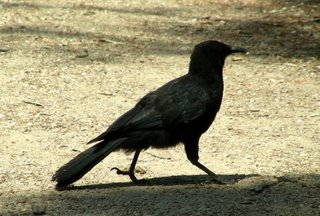 A flock of white-winged choughs dropped in to feed the other day. A friend remarked that choughs had an interesting disjunct distribution. (Yes, these are the sorts of conversations I have. These and the very undergraduate ones. And both are punctuated by not very well thought out rants.) He meant worldwide—they're found in Australia and the Himalayas.
A flock of white-winged choughs dropped in to feed the other day. A friend remarked that choughs had an interesting disjunct distribution. (Yes, these are the sorts of conversations I have. These and the very undergraduate ones. And both are punctuated by not very well thought out rants.) He meant worldwide—they're found in Australia and the Himalayas.'And Europe,' I said.
He looked at me doubtfully.
'Oh, yes, they're found in the Alps and along the western sea cliffs in Britain,' I said. 'I've got a book on crows, I'll look them up.'
'But they're not crows,' he said.
And there's that common name problem again. Choughs of all types belong to an evolutionary lineage (clade) of birds that includes birds of paradise, crows, ravens, jays and shrikes. The birds in this clade are clustered into three groups:
- birds of paradise
- crows, ravens, jays, shrikes and non-Australian choughs (Pyrrhocorax pyrrhocorax and P. graculus)
- white-winged choughs (Corcorax melanorhamphos) and apostlebirds
So the choughs are all related if you trace their ancestry back far enough but the two modern groups (Pyrrhocorax and Corcorax) are not the same. They share a common name because they look similar: they're mid-sized black birds with curved bills.
Pyrrhocorax choughs live on cliffs and mountains in the more remote parts of Europe and Asia. Their closest relative is a strange black bird, the ratchet-tailed tree pie (Temnurus temnurus) of China, which has a long tail like a row of fish bones.
 White-winged choughs are restricted to SE Australia, where they live in open woodland. Unlike the others, they are sociable birds that hang around in parties of up to a dozen individuals. They share this behaviour with their equally gregarious relatives, the apostlebirds Struthidea cinerea. (The Australian Museum has an MP3 file of the white-wings calls.)
White-winged choughs are restricted to SE Australia, where they live in open woodland. Unlike the others, they are sociable birds that hang around in parties of up to a dozen individuals. They share this behaviour with their equally gregarious relatives, the apostlebirds Struthidea cinerea. (The Australian Museum has an MP3 file of the white-wings calls.)Read more
Barker, FK, Cibois, A, Schikler, P, Feinstein, J. & Cracraft, J. (2004). Phylogeny and diversification of the largest avian radiation. Proceedings of the National Academy of Sciences of the United States of America 101 (30): 11040 – 11045.
Ericson, PGP & Johansson, US. (2003). Phylogeny of Passerida (Aves : Passeriformes) based on nuclear and mitochondrial sequence data. Molecular Phylogenetics and Evolution 29 (1): 126 – 138.
Jonsson, KA & Fjeldså, J. (2006). A phylogenetic supertree of oscine passerine birds (Aves : Passeri). Zoologica Scripta 35 (2): 149 – 186.